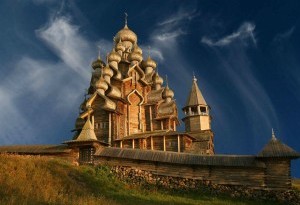The Church of the Transfiguration, Kizhi

In the XIV century, the Kizhi pogost was the administrative center of the villages located on the islands of Lake Onega. In the 17th century, a wooden wall with watchtowers was erected around the pogost. At the end of the 17th century, as a result of a lightning strike, a fire broke out on the pogost, which destroyed the churches. The Church of the Transfiguration was re-erected in 1714 with popular money.
The height of the Church of the Transfiguration is 37 meters, and it also has an unprecedented number of domes - 22. It is made, including domes and a cross, of wood, without nails, with an ax and chisel. By the way, the long life of Kizhi churches is explained by the fact that they were erected without using a saw - wood processing with an ax does not violate its structure, therefore the churches are not destroyed.
In the four-tier iconostasis 102 icons, two of them - the end of the XVII century.
The temple is summer, unheated, so that in winter there are no services in it.
"Kizhi" means "a place of play". In ancient times, local peoples, Karelians and Vepsians, celebrated their holidays here in honor of nature, performed ritual dances and games.
The church was built by an artel of carpenters from Zaonezh, and the whole district helped them. They built the same, as was established in Russia, not according to the projects and drawings, but according to the traditions that were orally passed down from generation to generation.
However, they say that the project of the church still was. And Peter the Great was the author of it: sailing past the island, he saw that the men were preparing to lay the temple, moored to the shore and drew a plan for the future church on the ground.
According to another legend, the Church of the Transfiguration was cut down by a certain master Nestor, and then symbolically threw his ax into Lake Onega with the words: "It was not, there is not and there will not be such a church".
Surprisingly, the war has bypassed Kizhi party. The Finnish pilot Laus Dei Saksel, who is called the Kizhi angel, is considered the savior of Kizhi: he received an order from the command to bomb Kizhi, but when the plane descended and the pilot saw the beauty of the Church of the Transfiguration, his hand did not rise to drop bombs on it. He flew away, dropping bombs to Lake Onega and risking falling under the tribunal. Whether it really was - is unknown.
LOCAL FEATURES
Weather
It is better to come in the period of navigation - from May to September. But in the winter you can also get here. The climate here is mild, rather humid, closer to the sea. Winter is cool, but without severe frosts. Summer is very cool. The average January temperature is -12 °, July + 15 °.
Events and holidays
In the summer, craftsmen and artisans in ancient costumes show visitors various types of ancient crafts: lace-making, pottery, carving, etc.
Join our tours and take a look at this amazing attraction:
Excursions - www.uvisitrussia.com/day-tours/tours-to-karelia/
Tours - www.uvisitrussia.com/tours-to-karelia/



